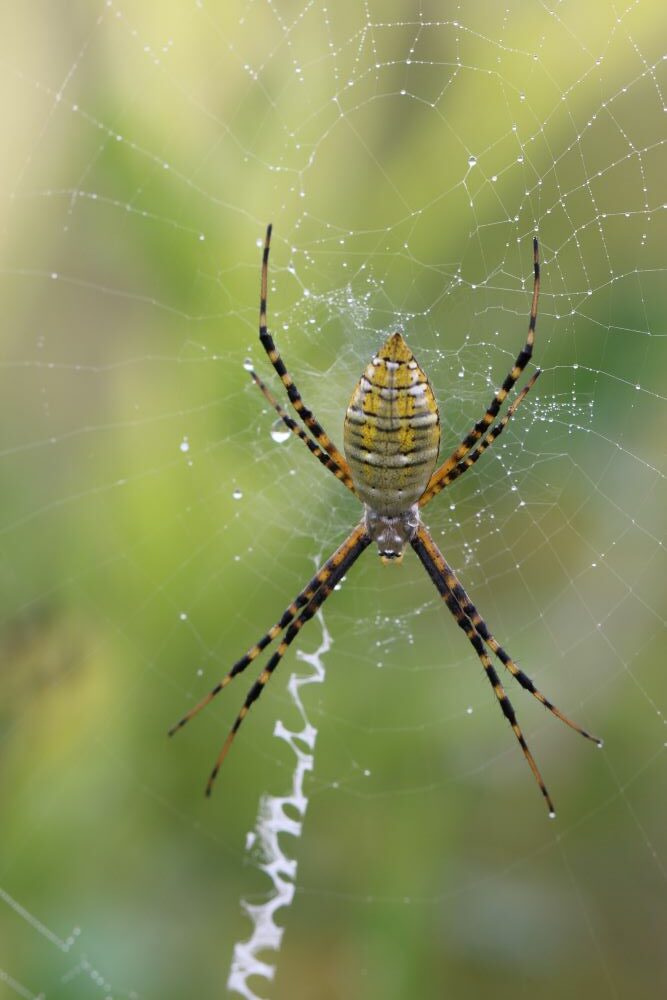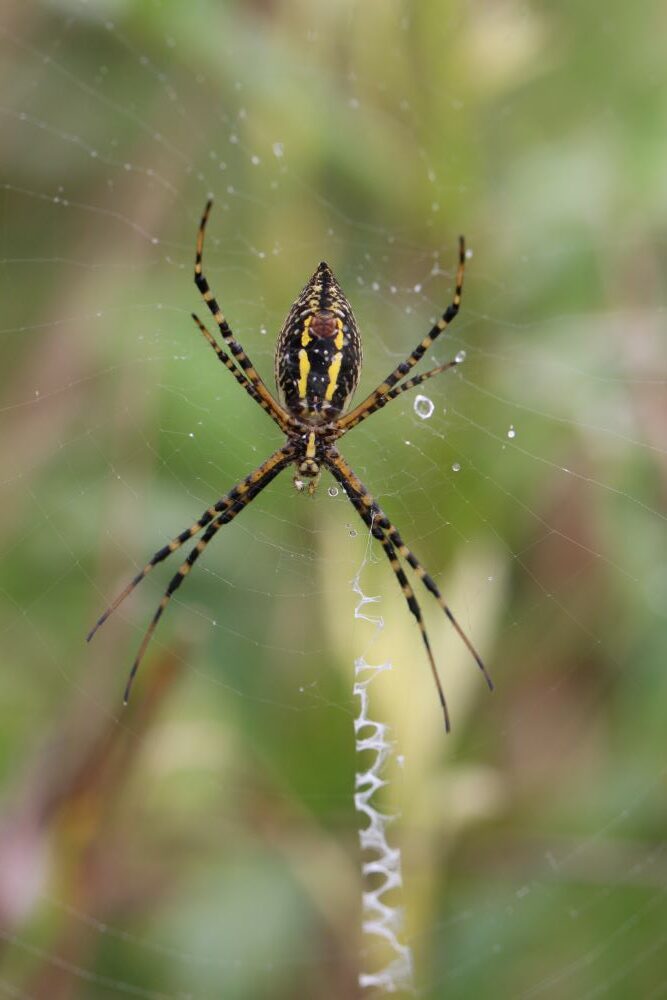As the nights started to cool down in late summer, dewy spider webs were displayed on just about every structure at the Farm Hub from fences, to gators, to tall vegetation. One morning in early September, when I walked along the farm road by one of our Kernza fields, there were dozens of large spider webs in an unmown area with old wooden pallets and overgrown vegetation; the webs were attached to any vertical structures in sight.
Huge webs with hundreds of water droplets covered the area. As fall approached, adult orb weavers had emerged from crevices to create these intricate and impressive webs. The architects were banded garden spiders (Argiope trifasciata). They are a species of orb weavers common throughout North America. Their webs can be admired throughout gardens and open fields and are more noticeable later in the summer as spiders mature. They are similar and often confused with the yellow garden spider (Argiope aurantia), but banded garden spiders have a faint U-shaped mark on their abdomen, and patterned silver and yellow lines with thicker black, spotty lines also on their abdomen. Their underside is black with two thick yellow lines from the center to the end of their body and small silver spots.


Banded garden spiders have annual life cycles. Adults breed once when they have fully matured, and female spiders produce over 1,000 eggs that overwinter in egg sacs attached to vegetation. Spiders slow down their activity as temperatures drop and eventually die in the first frosts. In the spring, the eggs hatch and young spiderlings disperse by ballooning in wind currents using silk strands – which sounds very fun for the young spiders! Then the cycle begins again.
Most of the spiders I saw in early September were hanging upside down on their webs, others were busy building their webs or capturing prey. Their large wheel-shaped webs are hard to miss especially if an overnight rain leaves water droplets lined up on the web strands. When I accidentally brushed my leg against a web, the spider would quickly drop down and hide under the vegetation.


No doubt, the spider webs that filled the unmown patch in the Kernza field were impressive. Argiope spiders build their intricate webs with a stabilimentum, a thick zigzag from the center to the edge of the web. These have been thought to serve different roles like making the webs more visible to larger animals such as birds to deter them from flying into and destroying the webs. However, there were a couple times I saw a large dragonfly and a grasshopper fly into a web, struggle in the sticky threads, but eventually ripped free and flew away. I wondered if this was due to how large the dragonfly and grasshopper were or because of the web itself. A study (Opell et al. 2019) found that web thickness and stickiness can vary seasonally most likely after female spiders reallocate resources from their silk material to producing their egg sacs.
By October 19, night temperatures reached 29° Fahrenheit at the Farm Hub and the next few nights had below freezing temperatures. In true fall fashion, by Friday October 21, the days had warmed up and I went to the Kernza field to see if I could find any egg sacs, thinking all adult spiders had completed their life cycle. After some time squatting to get at eye level with the surviving vegetation, I did not find any egg sacs. However, I did see many abandoned webs, and remnants of the spiders’ meals including wasps, grasshoppers, and flies wrapped up in silk. There were also some banded garden spiders still hanging out on their webs, seemingly soaking up the sun and a couple were in the middle of a grasshopper feast!
This is not the first time these garden spider webs had taken over vegetation and structures. Every year in late summer, their large webs can be seen everywhere. Next August, when night temperatures start to drop and dewy mornings begin, I’ll be keeping an eye out at the farm for the next generation of banded garden spiders.

References:
Banded Garden Spider (psu.edu)
Banded Garden Spider | Missouri Department of Conservation (mo.gov)
Opell, Brent D., and Sarah D. Stellwagen. “Properties of orb weaving spider glycoprotein glue change during Argiope trifasciata web construction.” Scientific reports 9.1 (2019): 1-11.
